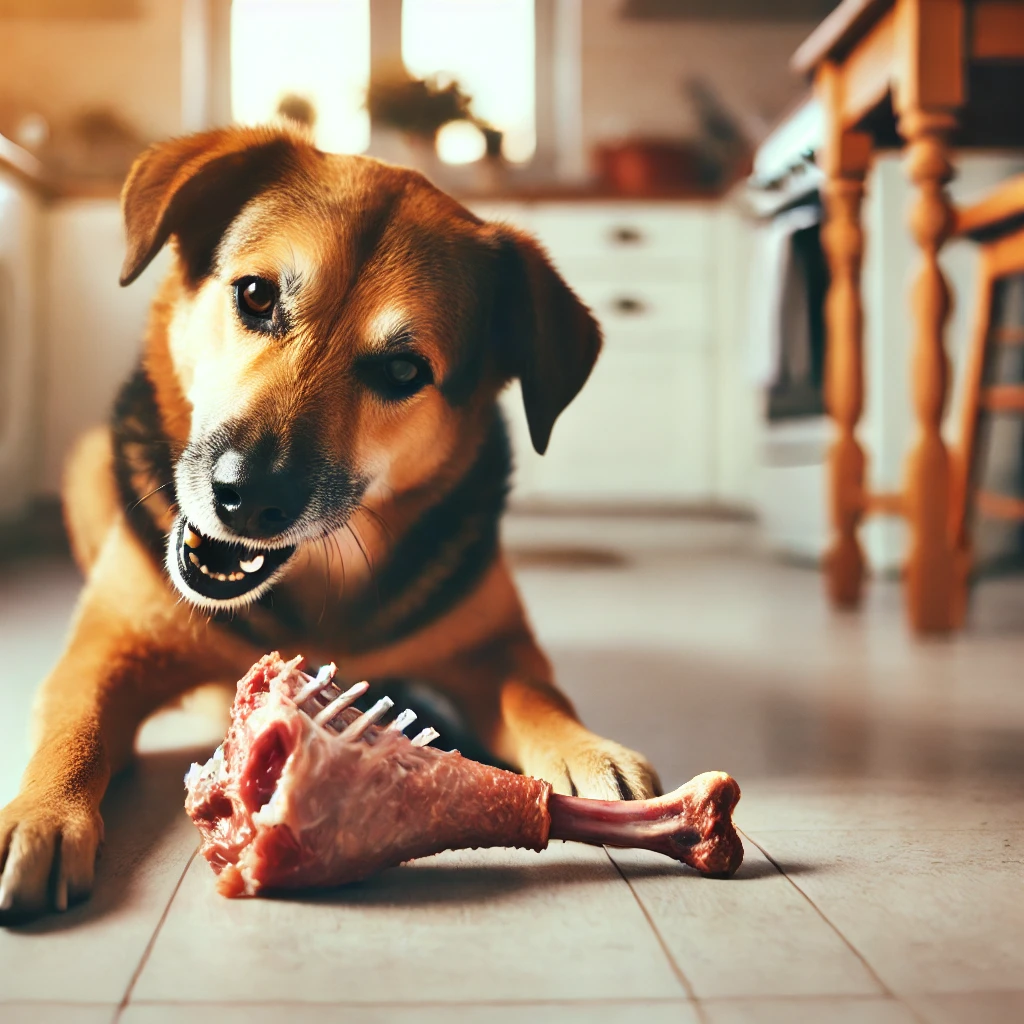Introduction
As a dog owner, you wonder if raw chicken bones are safe for your dogs. Can Dogs Eat Raw Chicken Bones? Many believe is that bones are a natural treat for dogs, but this is true? Let’s explore the facts.
Are Raw Chicken Bones Safe?
Raw chicken bones are softer and more easier than cooked bones. This means they are less likely to chip , making them generally safer for dogs to chew. However, there are still risks to consider.
Natural Chewing Activity
Chewing on bones can help keep a dog’s teeth clean and provide mental boost.
Nutritional Value
Raw bones contain calcium and other nutrients that are good for your dog’s health.
Choking Hazard
Small or sharp pieces can get stuck in your dog’s throat.
Digestive Issues
Some dogs may have sensitive stomachs and struggle to digest raw bones.
Bacterial pollution
Raw chicken can carry harmful bacteria like food poisoning, which might make your dog sick.
Broken Teeth
Hard bones can sometimes cause damage to your dog’s teeth.
Detailed Benefits of Raw Chicken Bones
When considering raw chicken bones as a treat for your dog, it’s essential to understand the potential benefits in more depth. These benefits are not just about immediate satisfaction but also long-term health and improvement for your pet.
Stress Reliever
Chewing is a great way to interrupt the dog and reduce worry.
Exercise
Chewing is an exercise for the jaws.
Prevents Destructive Behavior
Giving the dog the right things to chew on protects your things or shoes.
Calcium
Important for teeth and bones.
Phosphorus
Helps with energy-producing processes and maintaining bone honesty.
Collagen
Keeping the joints healthy and coat shiny.
Common Concerns and Myths
Many potential benefits, however, have led some dog owners to be hesitant about feeding their dogs raw chicken bones, and most of these concerns arise from myths or incomplete information. Some of these issues are addressed below:
Every Bone is Dangerous
Some bones are dangerous, and these are usually cooked bones; these mainly pose a threat to the dog, whereas raw bones are usually safe. Cooked bones splinter and become weak, while raw bones retain sufficient strength to be sufficiently soft to inflict no damage in the proper hands. Every Bone is Dangerous
Raw Chicken Always Will Give bacteria
Raw chicken may harbor bacteria such as germ, but dogs’ digestive systems are so well adapted to handle raw meat, much more so than humans. Their stomach acid is highly acidic and provides an efficient method of killing off any harmful bacteria. Yet some basic cleanliness measures, like washing your hands after handling raw chicken, are important.
Bones Can Replace a Balanced Diet
Bones should never be fed as the primary food of a dog. It is merely an extra or treat and cannot fulfill the nutritional needs of a balanced diet. Dogs need all sorts of nutrients that bones are not able to provide.
Guidelines for Feeding Raw Chicken Bones
In the event that you plan to feed raw chicken bones to your dog, make sure to do it by following responsible procedures. Here are the complete instructions for keeping your dog safe and loving raw chicken bones:
Supervision
Never allow your dog to chew on a bone without supervision. The supervision is there so that you can step in should the bone piece or should your dog try to drink it down whole.
Choose the Right Size
Select bones suitable for the dog’s size and chewing patterns. For example:
For small dogs:
Smaller bones such as chicken wings or necks.
For large dogs
Larger bones such as chicken thighs or chicken legs.
Freshness Matters
Use only fresh, good-quality raw chicken bones. Do not feed your dog bones that have been kept out for too long or are discolored.
Observe the Amounts
If too many bones are given, digestive issues such as stomach trouble could set in. Bone treats should be limited to 1-2 times a week depending on the size of the dog and their dietary requirements.
Situations Where Bones Should Not Be Fed
Though most dogs will enjoy raw chicken bones without any problems, there are situations that make it unsafe to give them:
Puppies and Older Dogs
Puppies with developing teeth and older dogs with dental issues may have trouble chewing bones safely.
Aggressive Chewers
Dogs that chew aggressively may break teeth or drink large pieces, increasing the risk of choking.
Digestive Sensitivities
Dogs prone to tummy troubles may not tolerate raw bones very well. Always consult your Animal if your dog has a sensitive stomach.
What to Do if Something Goes Wrong
Despite warnings, accidents can happen. Knowing how to respond can make all the difference:
Signs of Choking
If your dog is gagging, pawing at their mouth, or struggling to breathe, remove the bone carefully if visible. Seek Animal assistance immediately.
Digestive Blockages
Symptoms like vomiting, constipation, or abdominal pain may indicate a blockage. Contact your vet promptly for advice.
Proponents
Advocate for raw bones as a natural and enriching treat, provided safety guidelines are followed.
Opponents
Emphasize the risks of bacterial pollution and choking, suggesting safer alternatives.
Scientific Studies
Research indicates that raw bones can provide dental and nutritional benefits but highlights the need for careful handling to minimize risks.
Conclusion
Raw chicken bones can be a safe and enjoyable treat for many dogs, offering benefits like dental health and natural chewing satisfaction. However, they are not without risks. By follow best practices such as supervision choose the right size and monitoring your dogs reaction, you can reduce potential dangers. Always with your animals to determine if raw chicken bones are a good choice for your dog. Remember every dog is unique and what works for one may not work for another.







